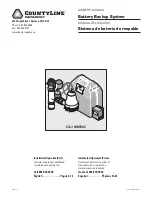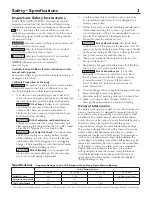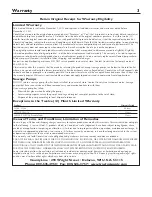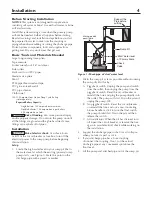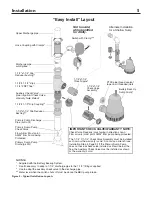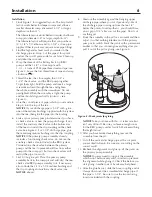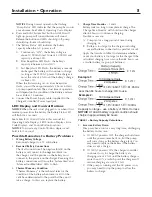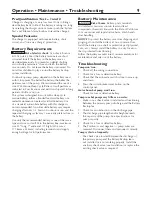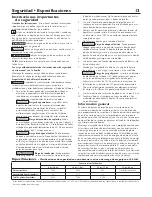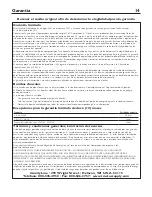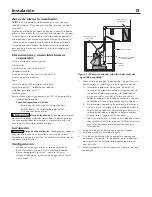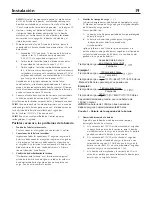
Installation
4
Before Starting Installation
NOTICE This system is not designed for applications
involving salt water or brine! Use with salt water or brine
will void warranty.
Install this system during a time when the primary pump
will not be needed. Gather all supplies before starting.
Read all warnings and installation steps before you start.
Be prepared for water to leak from the coupling or
piping when disassembling or cutting the discharge pipe.
Protect system components, tools and supplies from
getting wet. Dry any work areas that get wet.
Basic Tools and Materials Needed
Large tongue-and-groove pliers
Tape measure
Socket wrench or 5/16” nut driver
Side cutters
Hacksaw (to cut PVC pipe)
Medium size pliers
Pencil
PTFE pipe thread sealant tape
PVC glue (solvent weld)
PVC pipe cleaner
Cloth towel
100-120 Ampere-Hour Marine Deep Cycle Battery
(sold separately)
Required Battery Capacity:
Single Battery: 120 ampere-hour maximum.
Double Batteries: 100 ampere-hours per battery
(200 ampere-hours total)
Risk of flooding. Can cause personal injury
and/or property damage. Do not turn the pump on until
all the fittings are glued and the glue has dried. Loose
fittings can explode off of pipes.
Installation
Risk of electric shock. Can shock, burn
or kill. At the circuit breaker or fuse box, turn off the
electrical power to the sump pump before beginning
this installation.
Setup
1. Locate the high water level in your sump pit (that is,
the water level at which the existing (primary) sump
pump starts - see Figure 1). Mark this point on the
discharge pipe with a pencil or marker.
2. Drain the sump pit as far as possible without running
the pump dry. Do this by:
A. Piggyback switch: Unplug the pump and switch
from the outlet, then unplug the pump from the
piggyback switch. Reset the circuit breaker or
reinstall the fuse and plug the pump directly into
the outlet. The pump will start. Drain the pit and
unplug the pump. OR
B. No piggyback switch: Reset the circuit breaker
or reinstall the fuse and use a non-conducting
broom handle or stick to raise the float switch;
the pump should start. Drain the pit and then
release the switch.
C. All installations: When the pit has drained, turn
off (open) the circuit breaker or remove the fuse
again to avoid electrical shock while working on
the installation.
3. Support the discharge pipe so that it can’t collapse
when you take it apart or cut it.
4. If your discharge pipe has a hose coupling,
disconnect the coupling. If not, cut the vertical
discharge pipe at any convenient spot above the
floor level.
5. Lift the pump and attached pipe out of the sump pit.
‘Start’ water level
of Primary Pump
Sump Pit
Check
Valve
Support the
Pipe before
cutting.
5761 0108
Mark pipe with
pencil here.
Figure 1 - Mark pipe at ‘start’ water level
Summary of Contents for CL1800DC
Page 24: ......

